Introduction
By adopting a socially responsible conduct, organisations obtain many advantages, differentiate themselves from competitors and bring their contribution to the sustainable development. Different categories of stakeholders are exerting increasing pressures for the responsible performance of economic activities, James, M.L., (2015). These tendencies are manifesting more and more strongly in Romania, especially after the moment of integration into the European Union. Thus, those organisations that will understand the importance of the new requirements and will act in due time regarding the development of a corporate social responsibility are in advantage (CSR -Corporate Social Responsibility).
Organisations of all types and sizes are called to become socially responsible, ecologically sustainable and economically competitive, Orlitzky M. et al., (2011). Managers could try to maximise the benefits and value of their business, satisfying the expectations of interested parties. However, this maximisation of value cannot be measured only from a financial perspective, but also from a broader approach. The objective of the paper is to identify the challenges in disclosing aspects of corporate social responsibility in integrated reporting. Once these aspects are identified, we analyze the extent to which OMV Petrom has complied with the five essential principles of the organization’s ability to create long-term value.
Research Methodology
The research carried out supposed taking the following steps:
- Step one consisted of a documentation regarding the evolution of the process of integration of the corporate social responsibility aspects into the integrated reporting model within the OMV Petrom Group. In this regard, we studied the integrated reporting for the period 2014 – 2018 provided by OMV Petrom (available at https://www.omvpetrom.com).
- Step two: in this stage, based on the documentation made in step one, one proceeded to the performance of a research study that consisted of following the way in which the OMV Petrom Group captured the social responsibility aspects in the integrated reporting. At the same time, one also analysed how the integrated reporting models were adopted by OMV Petrom Group and the extent to which they respected the five essential principles of the capacity to create value, namely: connectivity of non-financial information; materiality, the concise character; reliability and completeness; consistency and comparability. In looking for the way to fulfil the application of the five principles, we identified the challenges of OMV Petrom Group in disclosing the social responsibility aspects, their its approaches, identifying some recommendations.
The management of corporate social responsibility aspects by the OMV Petrom Group is done by integrating them in the structure of the general governance of the organisation. These aspects are treated with the same importance as the economic aspects of the OMV Petrom Group, establishing an organisation scheme that corresponds to the key indicators of social performance. The employed experts of OMV Petrom Group maintain a continuous communication of the progress made in the field of social and environmental aspects, according to the strategy and the objectives of corporate social responsibility by disclosing them in the integrated reports.
The Social Responsibility Department has been developing and communicating for almost a decade the Social Responsibility Platform of the Group, entitled “Andrei’s Country”, contributing with its efforts and ideas to the fulfilment of the sustainability projects for the development of the community. The specificity of the activity sector of the OMV Petrom Group makes it address special precaution measures to support the protection of its employees, its assets, the environment and also the community where it operates. That is why, a first aspect of corporate social responsibility addressed by OMV Petrom Group in the integrated reports is health, safety, security and environment (HSSE).
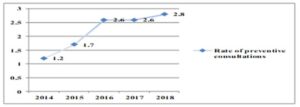
Figure 1: Rate of preventive consultations
The commitment of the organisation to lead a responsible activity led to the implementation of a vision called “No injuries-no loss”. This vision was implemented with the help of the HSSE2021+ strategy, in which the OMV Petrom Group tried to reduce the risk of employees’ illnesses. The HSSE2021+ strategy involved carrying out several campaigns: “Passport for health”, “Earn health: now!”, as well as over 36,000 screenings, which involved employees in creating a work environment that is beneficial to physical and mental health. During 2014-2018, the rate of preventive consultations increased, leading to a decrease in the risks of illness of employees (figure no.1).
Another aspect of social responsibility is workplace safety. In 2018, the program “Be smart, Be safe”, “Champion in the field of safety”, “Take safety home with you” was initiated, through which the organisation identified the risks in the field of safety, and internally certified over 1000 employees at training courses. Workplace safety represents an important goal for the organisation, which is why a series of modernisation and improvement projects have been initiated.
OMV Petrom Group has collaborated with various institutions (European Process Safety Centre, Center for Chemical Process Safety BEACON) for the elaboration of some studies for application and improvement. OMV Petrom Group complies with the recommendations of the International Association of Oil and Gas Producers regarding the key performance indicators for process safety. These indicators support learning from past events in order to make improvements in the future. In the integrated reporting from 2016-2018, the OMV Petrom Group shows a constant decrease of the TIER1 incidents and the maintenance of the TIER2 type incidents regarding the process safety, figure no.2.
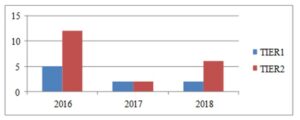
Figure 2: Process safety events
Another important corporate social responsibility aspect that is an integral part of the OMV Petrom group objective is environmental management. The organisation aims to minimise the impact of its activity on the environment over the entire life of its products. In order to achieve this objective, the organisation carried out a series of activities: they reviewed the environmental risk assessment registers and implemented measures to reduce them; they elaborated water and waste management reports; they implemented measures to reduce water use; they conducted studies on biodiversity assessment in the most important locations; they developed the Program “Modelling environmental values through performance” and evaluated its compliance with OMV/ISO14001 Standard.
As for the greenhouse gases (GHG), the OMV Petrom group initiated a project that resulted in the use of solar energy at points that distribute fuel. The results of this project showed a decrease of the impact of greenhouse gas emissions on the environment, resulting in substantial cost reductions, thus increasing social performance: GHG Goal 1 “Direct emissions from operations that are owned or controlled by the organisation” (figure no.3.) and GHG Purpose 2 “Indirect energy emissions resulting from generation of electric energy, heating, cooling or steam purchased” (figure no.4).
OMV Petrom Group shows in the integrated report of the year 2018 a tendency of decrease in the evolution of the impact of the activity on the environment at the level of 2017 compared to 2016 regarding direct GHG emissions. For the year 2018, the organisation explains the reached level of 4.5 million CO2 eq, slightly increased as being caused by the increase of electricity production.
The impact of GHG indirect emissions (emissions related to the production of energy purchased by the organisation for the activity performance) generally had a slight increase tendency generated by the increase of the quantity of electricity purchased in total consumption by the organisation. The organisation also claims that the purchased energy had higher green CO2 compared to 2017.

Figure 4: GHG indirect emissions

Figure 4: GHG indirect emissions
The social responsibility aspects captured in the integrated reporting of the OMV Petrom Group during 2014-2018 are synthetized in five main areas: business principles and social responsibility; safety, health, security, environment; efficient carbon management, employees and innovation. OMV Petrom Group will continue with these areas of interest for which it proposes commitments and objectives for the 2025 horizon (table no.1).
Table 1 : OMV 2025 Areas of interest and objectives of social responsibility

In its integrated reporting, OMV Petrom Group supports responsible behaviour towards all interested parties as a priority and not just an option in carrying out its activity. The integration of the corporate social responsibility aspects represents a journey of the organisation towards the promotion of the leadership test in sustainability. Integrated reporting represents such a good tool – in an era where organisations gain so much reputation for being transparent – that it is a pity to invest so much money, work and energy in a tool just to inform investors. Therefore, OMV Petrom Group considers larger target groups when identifying integrated reporting content. At the same time, the OMV Petrom Group believes that Web-based technology (a tool with all the features that make it simple and easy to use for information searching) can be used to meet the non-financial information needs of all interested parties.
Following the analysis of the integrated reports for the period 2014-2018, we tried to identify the manner of fulfilment of the application of the five essential principles when disclosing the social responsibility aspects. Thus, we identified what challenges the OMV Petrom Group deals with, what approaches it adopts and we identified some recommendations (table no.2).
Table 2: Non-financial information connectivity – identified challenges, approaches and recommendations
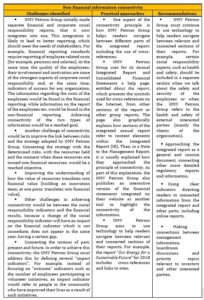
In an attempt to align with the guidelines of the European Union Directive 95/2014, the OMV Petrom group has developed a vast consultation process with all the stakeholders of the organisation in order to manage in identifying the material issues in the disclosure of the integrated reports. The result of these consultations was the identification of thirteen material aspects that show the major interest of the stakeholders for the impact that is generated by the activity of the OMV Petrom group (table no.3)
Table 3: Materiality – identified challenges, approaches and recommendations
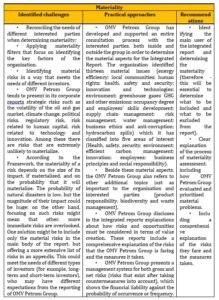
The challenges identified by OMV Petrom Group in revealing the aspects of social responsibility, practical approaches as well as recommendations for best practices for concision, are identified in table no.4.
Table 4: Concise character – identified challenges, approaches and recommendations
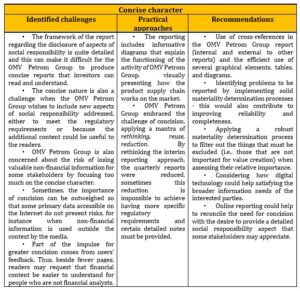
The probability that the integrated reporting of the OMV Petrom Group will fulfil its intended function, under set conditions of use, for a specified period of time, can be determined by its wish to include as much and as exhaustively as possible the aspects of corporate social responsibility (table no.5).
Table 5: Reliability and completeness – identified challenges, approaches and recommendations
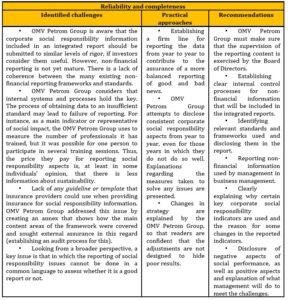
A consistent and comparable integrated report is the expected result by all interested parties of OMV Petrom Group (www.omvpetrom.com). In order to obtain such a report, the organisation took a step forward with each disclosed reporting, adapting to the rigour of the requirements of the stakeholders. However, OMV Petrom Group has encountered many challenges in reporting corporate social responsibility aspects (table no.6).
Table 6: Consistency and comparability – identified challenges, approaches and recommendations
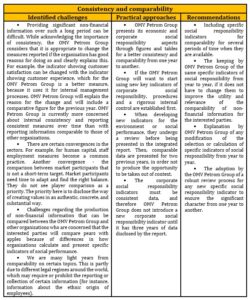
Conclusions and Discussions
Reporting information on sustainable development helps organisations define goals, measure performance, and adopt changes for the performance of more sustainable operations. A sustainability report provides information regarding the positive or negative impact of the actions of the organisation on the environment, society and the strategy of the organisation, Velte, P.; Stawinoga, M. (2017). The integrated reporting of any sustainable organisation must include the following elements: an overview of the performed activity and the external context, the risks, and opportunities of the activity, as well as the strategy and governance, IIRC (2013a.). All these content elements represent the business model that shapes the performance of the sustainable organisation.
Integrated reporting allows organisations to identify more clearly and fully what really drives them forward. This leads to a greater clarity regarding business management, determining the challenges and finding the opportunities. The next steps of integrated reporting are represented by the way technology can be used to help the interested parties to access more effectively the data they need. The organisations are aware that there are a lot of possibilities to display information, so it would be easier for the interested parties, especially the investors, to gather all the data they need and analyse them, Dura, C., Baron, O.D. (2015).
Following the documentation made on the integrated reporting of the OMV Petrom Group, we conducted research on how the corporate social responsibility aspects were captured in the integrated reports. Upon this research, it was outlined that the OMV Petrom Group has made sustained efforts to reduce pollution, being also concerned about the involvement in various corporate social responsibility actions. The case study revealed a significant presence of the term sustainability in the integrated reports published in the period 2014-2018. Moreover, the study carried out on the integrated reporting of the OMV Petrom Group highlighted a superior use of the corporate social responsibility aspects.
The annual integrated reports of OMV Petrom Group for 2014-2018 include information on the financial, social, and environmental performances. They also include long-term social and environmental goals. Each integrated report also provides a brief explanation of the performance against the goals related to water and energy consumption, also providing the context necessary to assess the social performance of the organisation. In this manner, the OMV Petrom Group has demonstrated its responsibility regarding its performance.
In its 2014 Annual Report, the OMV Petrom Group included for the first time a statement of the Board of Directors and of the executive management, according to which the report was prepared in compliance with the GRI international standards. One defines in the report the principles and content for filling in sustainability reports and they are submitted to the GRI context indexing standard. The sustainable development goals approved by the General Assembly of the United Nations, which OMV Petrom Group integrates in its strategy, are presented in the annex Areas of interest and the objectives of social responsibility OMV 2025.
OMV Petrom Group states that they have approached a continuous process to improve quality and control over environmental and social data. The audit committee requested that all non-financial data have the same validity as the financial data. The chapters on human capital management and environmental management include indicators whose sphere includes information about group affiliates due to the impact of the problems shown by the report. This applies to biodiversity indicators and labour force indicators. Once this process was finalised, the Audit Committee accepted that all data are of equivalent quality. For the integrated reports of OMV Petrom Group to make specific reference to the compliance with the international integrated reporting framework, a separate process has been conducted. In this way, the report offers a complete and balanced overview of the group’s position and performance, while also demonstrating responsibility, concision, materiality, and reliability.
OMV Petrom Group has understood that it must develop its understanding and capacity to integrate corporate social responsibility practices into its business strategies, because such activities can lead to long-term profits, competitive advantage, and consolidation of the product position on the market. The result of all social responsibility activities is the creation of long-term value of the organisation.
The way in which OMV Petrom has approached the best practices of corporate social responsibility in integrated reporting could serve as examples for other organizations to change their paradigm and make the CSR strategy part contribute to their business.
A future way of research that we intend to explore is the possibility of developing a theoretical model to establish the thematic representation of the best aspects of corporate social responsibility in integrated reporting that can be followed by other organizations operating in similar branches or in affiliated sectors.
Acknowledgment
This work was supported by the grant POCU380/6/13/123990, co-financed by the European Social Fund within the Sectoral Operational Program Human Capital 2014-2020.
(adsbygoogle = window.adsbygoogle || []).push({});
References
- Dura, C., Baron, O.D. (2015) ‘Best Practices in Romanian CSR: Petrom OMV’s Strategy‘, Calitatea, 16(149), 62.
- Ienciu, I.A., et al. (2014) ‘Study on Non-Financial Reporting in Accordance with European Directives in the Case of Romanian Companies‘, Audit Financiar Journal, 12 (9), 43-49.
- James, M.L. (2015) ‘The benefits of sustainability and integrated reporting: An investigation of accounting majors’ perceptions, ‘ Journal of Legal, Ethical and Regulatory, 18(1), 1-20.
- Man, M., Măcriș, M. (2015) ‘Integration of corporative governance into organisation’s social responsability system, ‘ Polish Journal of Management Studies, 11(2), 100-114.
- Orlitzky, M., Siegel, D.S., Waldman, D.A. (2011) ‘Strategic corporate social responsibility and environmental sustainability, ‘ Business & society, 50(1), 6-27.
- Păunescu (Petre) C.F., Man, M. (2019) ‘Aspects regarding the Binomial Social Accounting – Social Performance within Social Responsibility of Romanian Organisations, ‘ Proceeding of 34th. International Business Information Management Conference (34th IBIMA), Madrid, Spain, 3966-3978.
- Velte, P., Stawinoga, M. (2017) ‘ Integrated reporting: The current state of empirical research, limitations and future research implications, ‘ Journal of Management Control, 28(3), 275–320.
- The International Integrated Reporting Council, (2013a.) Consultation draft of the international <IR>Framework.[online]http://integratedreporting.org/wpcontent/uploads/2013/03/Consultation-Draft-of-theInternationalIRFramework.pdf> [Accessed 01-07 November 2019].
- The International Integrated Reporting Council (2013b)the International <IR> Framework [online]
- http://integratedreporting.org/wpcontent/uploads/2013/12/13-12-08THEINTERNATIONAL-IR-FRAMEWORK-2-1.pdf> [Accessed 01-07 November 2019].
- Reported,(2020)[online].https://integratedreporting.org/wpcontent/uploads/2017/04/ACCAInsights_intoIntegrated_Reporting.pdf> [Accessed 12-15 January 2020].
- OMV Petrom, [online] https://www.omvpetrom.com/ro , [Accessed 10-19 February 2020].
- OMV Petrom, Rapoarte de sustenabilitate, [online] https://www.omvpetrom.com/ro/sustenabilitate/ rapoarte-de-sustenabilitate [Accessed 10-19 February 2020].












